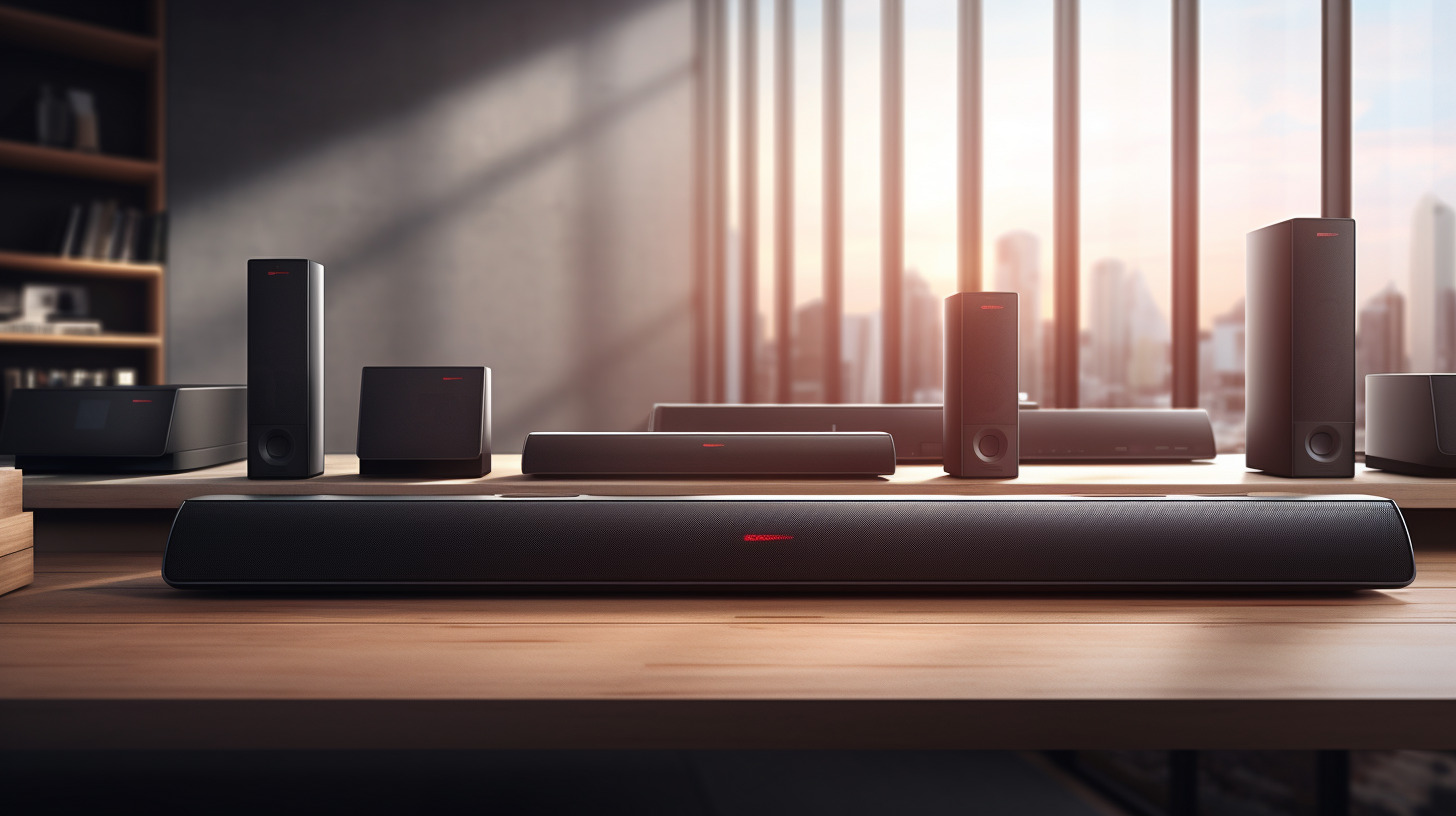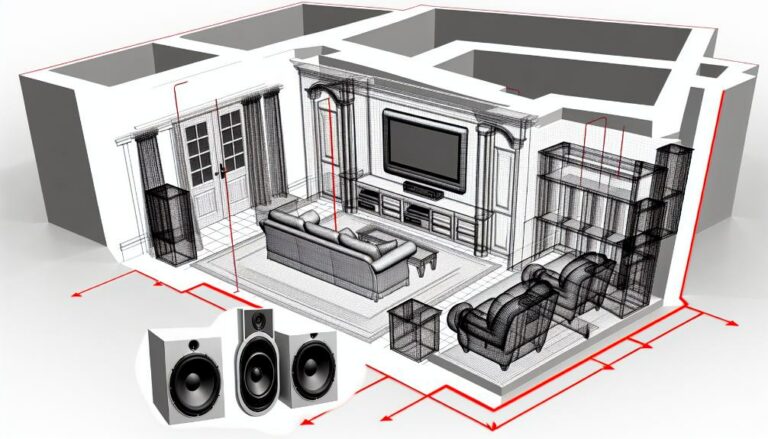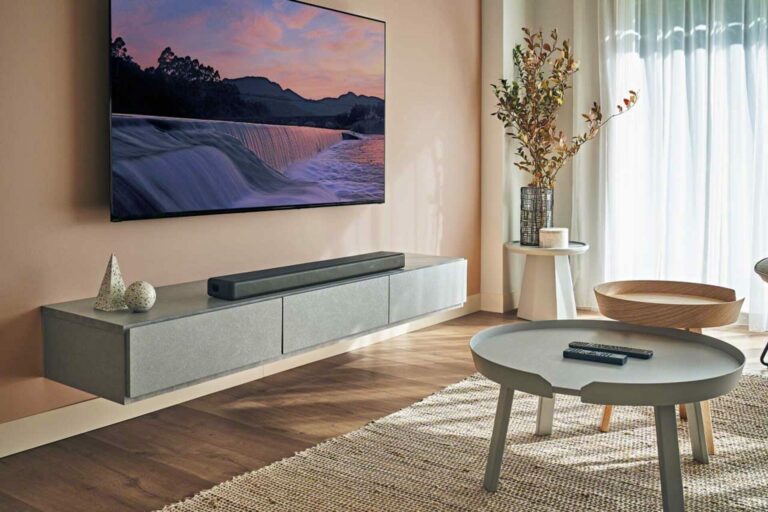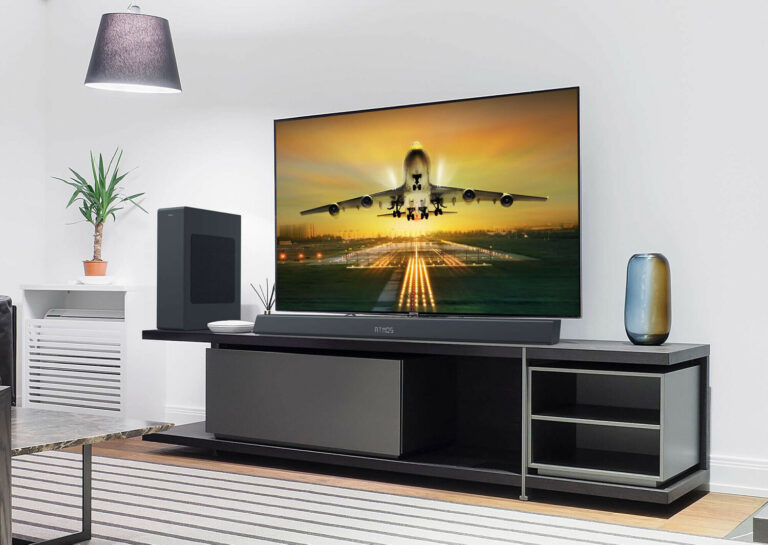Soundbars are an integral component of modern home entertainment systems. They are elongated, sleek devices that house multiple speakers, providing superior audio quality compared to standard television speakers. Soundbars can significantly enhance the audio experience, rendering crisp dialogue and delivering well-defined, powerful sound effects.
Whether you’re watching a thrilling action movie, listening to your favorite music, or even playing video games, a soundbar can transform an ordinary audio experience into an immersive aural adventure. In the realm of home entertainment, investing in a good soundbar is important to fully appreciate the rich complexity of sound that today’s digital media offers.
Sound Review Hub’s Comprehensive Soundbar Buying Guide is designed to be your ultimate companion in choosing the perfect soundbar for your home or space. It takes you through a comprehensive understanding of key features, technical specifications, and the range of soundbars available, enabling you to make an informed choice based on your specific needs and preferences.
Whether you’re a novice or a sound connoisseur, this guide will simplify the daunting process of selecting a soundbar, ensuring that your investment delivers the optimal audio experience.
Understanding Soundbars
Soundbar Basics: What is a Soundbar?
A soundbar, also known as a media bar, is an all-in-one speaker system that delivers high-quality TV sound. Unlike home theater systems with multiple speakers spread across the room, soundbars incorporate all their speakers into one long bar-shaped device. This bar can be placed below or above your TV or even mounted on the wall.
Despite their sleek and compact design, soundbars can dramatically improve your TV’s audio quality, making every movie, song, or video game more immersive and enjoyable. Soundbars can vary in size, features, and price range, providing options for every user’s needs and preferences.
Soundbars vs. Other Home Audio Equipment
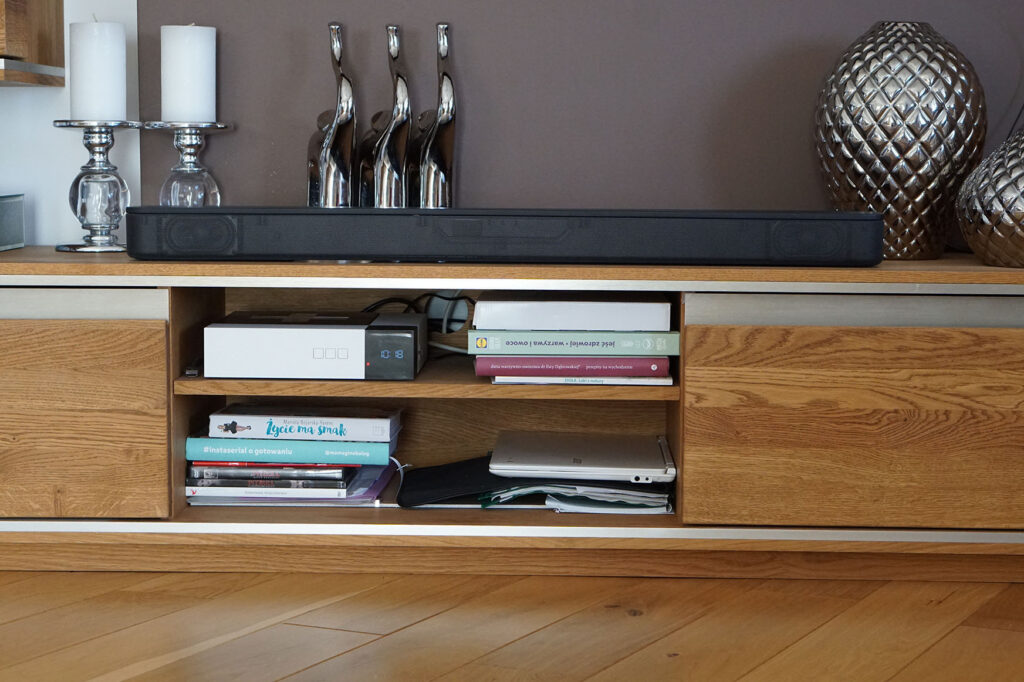
Soundbars vs. Speakers
While both soundbars and speakers deliver audio output, they have significant differences. Speakers, especially standalone units, often require the addition of an amplifier or receiver and, in many cases, complex wiring for setup. They can provide excellent sound quality but may take up more space and aren’t as visually streamlined as soundbars.
On the other hand, soundbars are all-in-one systems that include amplification, and they provide a neat and compact solution without the need for multiple components or cables. They’re designed to fit conveniently under your TV or on the wall, making them a perfect choice for space-limited setups or for those seeking a minimalist aesthetic.
Soundbars vs. Home Theater Systems
Home theater systems typically include multiple speakers (like front, center, and rear speakers) and a subwoofer, which are arranged around the room to create a surround sound effect. While this setup can deliver a dynamic, theater-like audio experience, it might require more space and a more complex setup, including wiring and calibration.
Conversely, a soundbar simplifies this process by incorporating multiple speakers into one device, requiring less space and offering easier installation. While it might not reproduce the same enveloping effect of a full home theater system, many high-end soundbars now include technologies like Dolby Atmos, which can convincingly simulate a surround sound experience.
Why Choose a Soundbar?
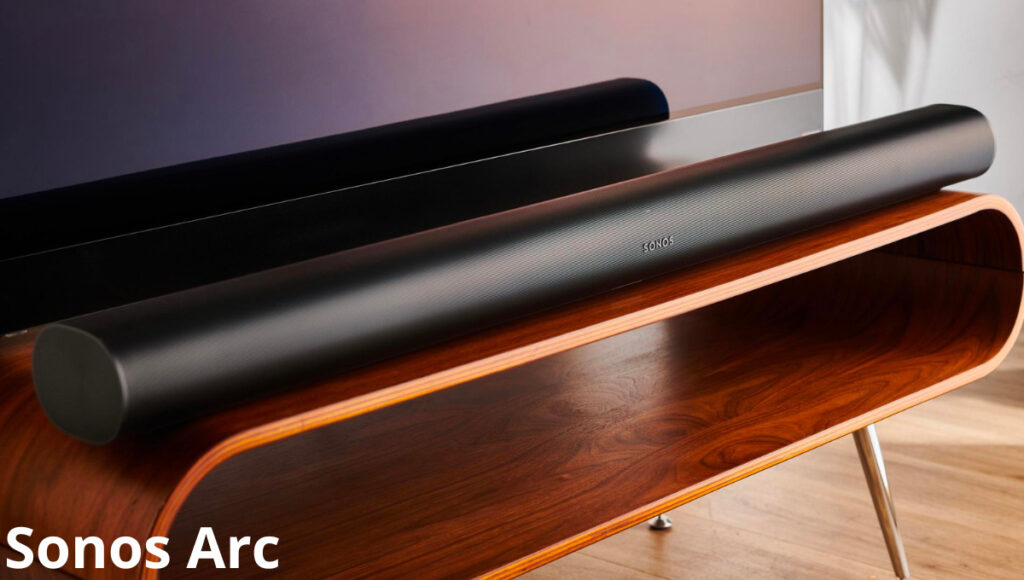
Benefits of Using a Soundbar
Soundbars have many advantages, making them an excellent choice for enhancing your audio experience. Here are some key benefits:
- Improved Audio Quality: The foremost benefit of a soundbar is the substantial improvement it brings to your TV’s audio quality. From clearer dialogues to more profound bass and fuller sound, a soundbar dramatically enhances the overall aural experience.
- Space-Saving Design: Soundbars sports a sleek, compact design that fits seamlessly into any space. Compared to traditional home theater systems, their minimalistic design makes them a great choice for small rooms or apartments.
- Easy Installation: With a soundbar, you won’t have to worry about complex wiring or setting up multiple speakers. Most soundbars can be set up with just a few connections, making the installation process a breeze.
- Cost-Effective: Soundbars offer a more cost-effective solution than buying individual home theater system components. Especially if you’re on a budget, soundbars can provide high-quality sound without the hefty price tag.
- Enhanced Features: Many soundbars come with added features like Bluetooth connectivity for wirelessly streaming music and built-in voice assistants, such as Apple Siri, Google Assistant, and Amazon Alexa. These features provide additional value and convenience, making the soundbar an even more attractive option.
Situations Where a Soundbar is the Ideal Choice
There are several scenarios where a soundbar emerges as the ideal choice for an audio system:
- Limited Space: If you’re living in a small apartment or have a compact living room, the sleek design of a soundbar will fit seamlessly into your space without creating clutter.
- Simplified Setup: If you prefer a plug-and-play approach and want to avoid the hassle of complicated wiring and setup, a soundbar provides a straightforward solution.
- Budget Constraints: If you want a superior audio experience but have a restricted budget, soundbars offer a cost-effective alternative, delivering excellent sound without burning a hole in your pocket.
- Minimalist Aesthetic: A soundbar’s sleek and streamlined design is an attractive option for those who appreciate minimalism and want to maintain a clean, uncluttered look in their entertainment area.
Types of Soundbars
Standalone Soundbars
Standalone soundbars, as the name implies, are soundbars that function independently without the need for any additional components. They are ideal for those who desire a quick and straightforward audio upgrade without the complexity of setting up additional features.
Standalone soundbars typically have built-in subwoofers for an enhanced bass experience, but they might lack the profound bass and surround sound capabilities seen in more comprehensive systems.
Soundbars with Subwoofers
Soundbars with subwoofers are popular for those seeking an extra kick in their audio experience. The wired or wireless subwoofer enhances the bass output, providing depth and richness to the sound.
This type of soundbar system is perfect for movie enthusiasts who enjoy feeling the rumble of action scenes. However, they will take up more space, and the wireless models may require an extra power socket.
Soundbars with Subwoofers and Surround Speakers
For the ultimate cinematic experience in the comfort of your home, soundbars with subwoofers and surround speakers are the way to go. This setup includes a soundbar, a subwoofer for deep bass, and additional speakers around the room to envelop surround sound.
This type of soundbar provides the most immersive audio experience, making you feel like you’re in the middle of the action. The downside is that setting up the extra speakers can add complexity and require more space.
Soundbase Soundbars
Soundbase soundbars, otherwise known as pedestal soundbars, are designed to serve as a base for your TV. They are larger and typically more powerful than standard soundbars, offering an amplified audio experience without compromising space.
Soundbase soundbars can produce deeper bass and better resonance due to their larger size. However, their size also means they might not fit neatly with all TV setups, especially wall-mounted ones.
As you mull over the different types of soundbars, consider your unique living situation, budget, and audio preferences. Remember, the perfect soundbar isn’t merely the most advanced or expensive one; it’s the one that best fits your needs and enhances your audio experience.
Key Features to Look for in a Soundbar
Audio Quality
The first and foremost aspect to consider is the audio quality of the soundbar. Look for a soundbar that delivers a well-balanced sound, clear dialogue, and deep bass. Pay attention to technical specifications such as audio channels and wattage, but remember that the ultimate test of audio quality is how it sounds to you.
Connectivity
Modern soundbars offer a range of connectivity options to cater to your needs. Look for soundbars that offer Bluetooth and Wi-Fi connectivity for wireless streaming. HDMI and Optical ports are essential for connecting your soundbar to your TV and other devices. Some soundbars may also offer USB ports and aux-in connections for added flexibility.
Compatibility
Ensure your chosen soundbar is compatible with your existing devices, such as your TV, Blu-ray player, gaming console, and other home theatre system components. Some soundbars are designed to work seamlessly with specific brands or models.
Additional Features
Consider soundbars that offer additional features like built-in virtual assistants (Amazon Alexa, Google Assistant, or Apple Siri) for hands-free control. Dolby Atmos technology is a desirable feature for a more immersive, three-dimensional sound experience, especially for movie and gaming enthusiasts. Some soundbars also offer sound modes and EQ settings to customize your listening experience further.
Remember, the best soundbar is the one that suits your needs and enhances your audio-visual environment. By considering the audio quality, connectivity, compatibility, and additional features, you can ensure that you choose the perfect soundbar for your home.
Top Brands in the Market

Sonos
Famed for its multi-room audio systems, Sonos offers soundbars that deliver superior sound quality and seamless integration with other Sonos devices. The high-end Sonos Arc provides a truly immersive, Dolby Atmos-enabled audio experience, while the affordable Sonos Beam is compact yet powerful, offering incredible value. However, Sonos products are typically pricier.
Samsung
Samsung is a household name in electronics, with a reputation for reliable and innovative products. The flagship Samsung HW-Q90R offers Dolby Atmos and DTS:X support, delivering an incredible cinematic sound experience. The budget-friendly Samsung HW-T550 features a dedicated center channel for clear dialogues. Some users have reported issues with Samsung’s customer service.
LG
LG excels in combining impressive sound quality with stunning aesthetics. The high-end LG SN11RG boasts Dolby Atmos, Meridian tuning, and Google Assistant integration. The LG SK1 is an excellent choice for budget-conscious customers. The LG SK1 provides robust performance for its size. However, LG’s soundbars may lack the punchy bass provided by some competitors.
JBL
JBL is renowned for its robust, bass-heavy sound, evident in its flagship JBL Bar 9.1, which offers detachable speakers for a true wireless surround sound experience. The JBL Bar 2.1 is an affordable option that doesn’t skimp on power or quality. However, JBL soundbars often favor bass over mid and high frequencies.

Klipsch
Klipsch offers high-quality, professional-grade audio equipment. The premium Klipsch Cinema 1200 comes with Dolby Atmos, while the budget-friendly Klipsch R-10B delivers a rich, full-bodied sound. However, some users may find Klipsch products to be over their budget.
Sony
Sony is a reliable choice for high-quality audio equipment. The flagship Sony HT-ST5000 delivers exceptional sound with Dolby Atmos support, while the affordable Sony HT-S350 is simple yet effective, offering robust sound. Sony’s user interface and remote design could use improvement, though.
Panasonic
Panasonic soundbars are known for their clear and detailed sound. The top-of-the-line Panasonic SC-HTB900 comes with Dolby Atmos and DTS:X, while the affordable Panasonic SC-HTB208 offers balanced sound for a great price. Panasonic soundbars, however, might lack the aesthetic appeal of other brands.
Polk Audio
Polk Audio offers a range of soundbars that deliver excellent value for money. The Polk Audio Command Bar integrates Amazon Alexa and offers impressive sound quality. The Polk Audio Signa S2 offers a compelling performance on a budget. Polk’s soundbars, however, may not match the sheer power output of some competitors.
VIZIO
VIZIO excels in delivering excellent sound quality at affordable prices. The top-tier VIZIO SB46514-F6 offers Dolby Atmos at a very competitive price, and the budget-friendly VIZIO SB2920-C6 offers an impressive sound for its price. VIZIO’s customer service could be better, though.
Yamaha
Yamaha soundbars deliver crystal clear sound with a focus on authenticity. The high-end Yamaha YSP-5600 uses sound projection technology for a 3D sound experience, while the affordable Yamaha YAS-109 provides excellent sound quality with built-in Alexa. Yamaha’s MusicCast app, however, can be tricky to navigate.
Price Considerations
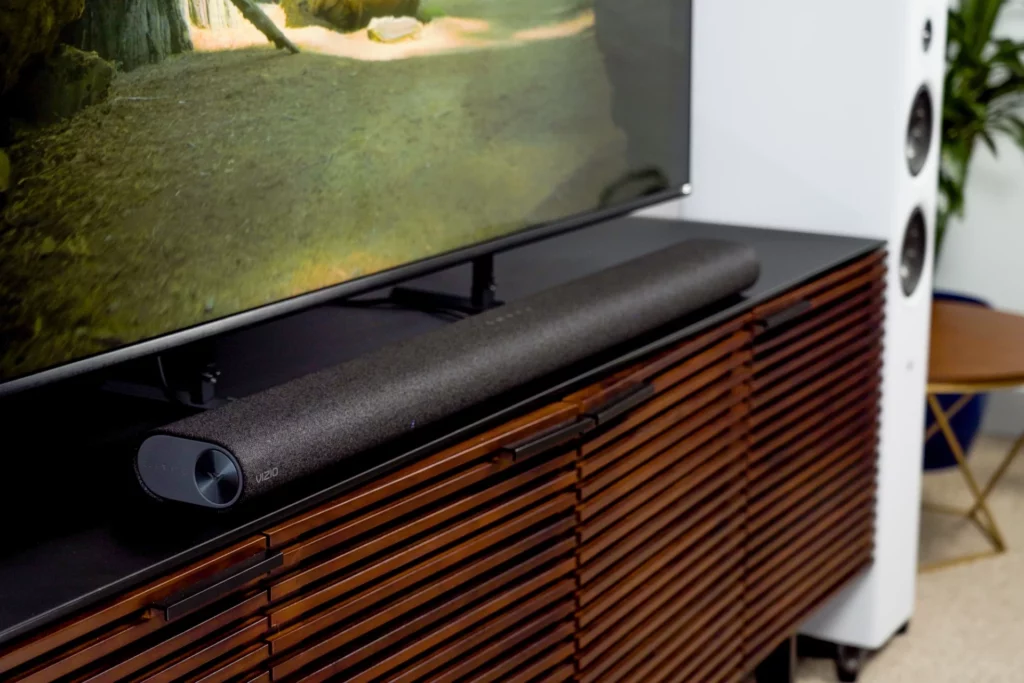
Soundbars come in a variety of price ranges, catering to every budget, from the economically-minded shopper to the high-end audiophile.
Lower-end models, costing around $100 to $200, offer basic features with satisfactory audio quality.
Mid-range soundbars, priced between $200 and $800, typically provide superior sound quality, additional audio channels, and more connectivity options.
High-end soundbars, often exceeding $800, deliver the best audio quality with advanced features like Dolby Atmos, DTS:X, and wireless surround sound.
The price of a soundbar is influenced by several factors, including the brand, the quality of materials, the audio technology used, the number of channels, and extra features like built-in virtual assistants or wireless subwoofers.
For instance, a Dolby Atmos-enabled soundbar with a wireless subwoofer from a premium brand like Sonos or Klipsch will cost significantly more than a basic 2-channel soundbar from a budget brand.
When selecting a soundbar that fits your budget, consider what features are most important to you.
Are you seeking superior audio quality for an immersive movie-watching experience? Do you need a soundbar with built-in smart capabilities? Or are you simply looking for a soundbar that delivers better sound than your TV speakers?
Answering these questions will help you narrow down your options and find a soundbar that delivers the best value for your money. Remember, the most expensive soundbar isn’t always the best—it’s the one that meets your needs and enhances your audio-visual enjoyment.
Where to Buy Soundbars
Soundbars are readily available for purchase, both in physical stores and online. Brick-and-mortar stores such as Best Buy, Target, and Walmart stock a wide variety of soundbars. These stores provide a hands-on experience, allowing you to view the product, judge its size and aesthetics, and sometimes even test its sound quality before making a decision. However, their selection might be limited compared to online stores, and prices may be higher due to overhead costs.
Online retailers like Amazon offer a vastly larger selection, often at more competitive prices. Amazon provides detailed product descriptions, customer reviews, and Q&A sections to help you make an informed decision. And with its fast Prime 2-day shipping, you can start enjoying your soundbar almost as quickly as if you bought it in-store.
The easy return policy is one of the most significant advantages of buying online. For example, Amazon collaborates with UPS, making it convenient to return a product if it doesn’t meet your expectations. Simply repack the soundbar, print out a pre-paid shipping label, and drop it off at UPS.
Therefore, while both online and physical stores have their benefits, Amazon stands out due to its wide selection, competitive prices, fast shipping, and generous return policy. When buying a soundbar, especially a high-end model, having the ability to return or replace it easily can provide peace of mind. So, based on these considerations, we highly recommend considering Amazon as your go-to choice when purchasing a soundbar.
Setting Up Your Soundbar
- Connect your soundbar to your television using the most effective connectivity option, such as HDMI ARC or optical audio output.
- Adjust your TV audio settings to output sound through the external soundbar instead of its built-in speakers.
- Position your soundbar directly under your television, centered and aligned with the TV screen.
- If your soundbar has a separate subwoofer, place it near the TV (avoid corners to prevent heavy bass).
- Connect soundbars with built-in smart capabilities to your home Wi-Fi using the manufacturer’s app.
- Use the app to control your soundbar’s settings for optimal sound quality.
- Regularly update your soundbar’s software and firmware to improve performance and access new features. (Tip: set your settings to install the latest updates automatically.)
- Explore different sound modes (e.g., ‘Movie,’ ‘Music,’ ‘News,’ ‘Sports’) and choose the one that suits your content.
- Consider using room calibration technology, if available, to customize the sound based on your room’s acoustics.
By following these steps, you can set up your soundbar for a high-quality audio experience that enhances your entertainment.
Soundbar Maintenance and Troubleshooting
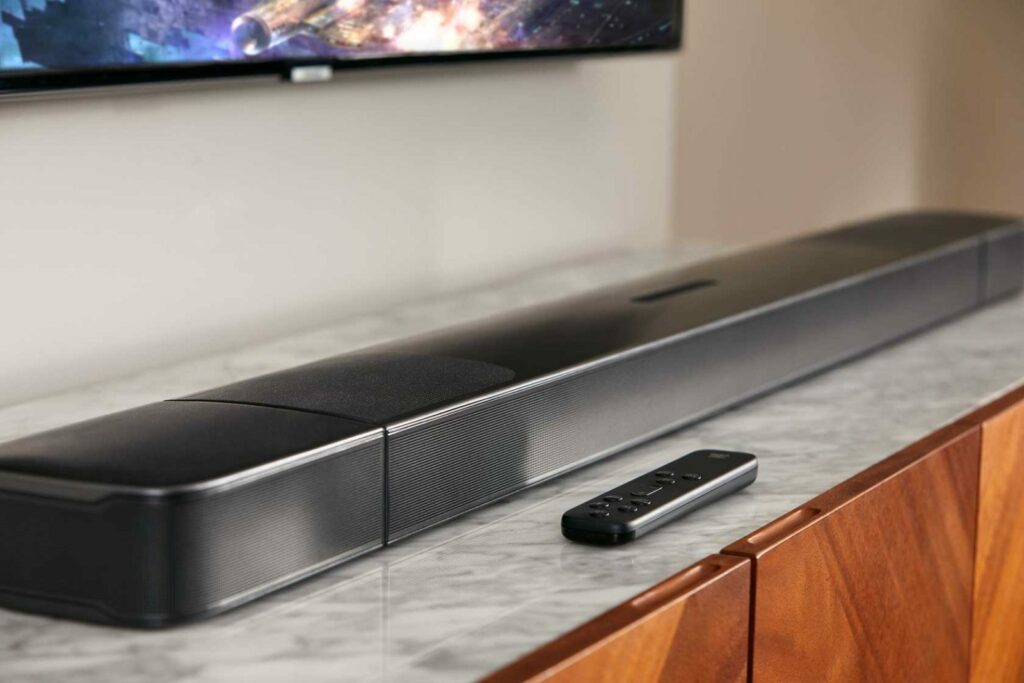
Maintaining Your Soundbar
Proper maintenance of your soundbar can extend its life and preserve the quality of sound it produces. Dust and debris can clog your soundbar, affecting its performance over time. Therefore, it’s crucial to keep your soundbar clean.
Use a microfiber cloth to gently dust off the surface, ensuring not to press too hard to prevent damage. Avoid using any harsh cleaning products as they can harm the delicate materials. If your soundbar has removable grilles, take them off and gently clean them separately.
Soundbars are sensitive to heat and moisture. Keep your soundbar in a cool, dry place, and avoid placing it near heating sources or in direct sunlight. Also, don’t let it get wet; if you are cleaning around it, switch it off and ensure it is thoroughly dry before turning it back on.
Troubleshooting Common Soundbar Issues
Despite best maintenance practices, you may occasionally face issues with your soundbar. Here are solutions to some common problems:
- No Sound or Poor Sound Quality: Check all cable connections and ensure they are secure. Check that the right input is selected on your soundbar. If you’re using Bluetooth, check that the device is paired properly. If the sound quality is poor, try adjusting the bass, treble, or subwoofer levels, or try different sound modes if available.
- Subwoofer Not Working Properly: Ensure that the subwoofer is turned on and paired with the soundbar. Try moving the subwoofer closer to the soundbar, as distance or obstacles can affect connectivity.
- Remote Not Working: Check the batteries in the remote. If replacing the batteries doesn’t work, there could be an issue with the remote itself, and you might need to replace it.
- Soundbar Not Pairing with TV: Check to see if both your TV and soundbar support the same form of connection (HDMI ARC, optical audio). You might need to adjust the sound settings on your TV to output the sound to the soundbar.
If you still encounter issues after trying these solutions, check the user manual or contact the manufacturer’s customer service for further assistance. Remember, regular maintenance and troubleshooting can ensure your soundbar delivers high-quality sound for years to come.
Final Thoughts
A soundbar can significantly upgrade your home theater experience, delivering powerful, immersive audio that your TV’s built-in speakers can’t match. Whether you’re buying from a physical store or online, you need to consider factors like size, aesthetics, sound quality, price, and the vendor’s return policy. Setting up and maintaining your soundbar properly will ensure it delivers high-quality sound for years to come. Even if you face issues, most common problems have straightforward solutions.
We at Sound Review Hub are committed to assisting you in your journey to find the best soundbar for your needs. We regularly update our website with informative articles and reliable product reviews to help you make an informed decision. If you have any questions or need help with your soundbar buying process, don’t hesitate to reach out to us. After all, your sound experience deserves the best!
Frequently Asked Questions
Do I need a separate subwoofer with my soundbar?
Not necessarily. Some soundbars come with a built-in subwoofer, providing a decent bass response. However, you might want to consider a soundbar with a separate subwoofer for a richer, deeper bass. The choice largely depends on your preferences and the audio experience you desire.
What is the best soundbar brand that Sound Review Hub recommends?
Sound Review Hub believes that the big brands, such as Sonos, Samsung, LG, Klipsch, and Sony, all make great soundbars. It boils down to individual preferences and budget. We recommend reading our detailed soundbar reviews to find the right one for you!
What is room calibration technology?
Room calibration technology is a feature found in some high-end soundbars that use algorithms to adjust settings based on your room’s acoustic characteristics. This ensures an optimal listening experience by customizing the sound output for your environment.
What is the difference between Dolby Atmos and DTS:X?
Dolby Atmos is an immersive surround-sound audio format that adds overhead sound effects from multiple speaker angles. DTS:X is a competing technology that also provides an immersive audio experience with height channels and object-based sound. Both technologies are designed to create a realistic 3D soundstage, but Dolby Atmos tends to be more popular among consumers because of its compatibility with more devices.
Does my soundbar come with a warranty?
Most soundbars come with a one-year warranty. However, some brands offer extended warranties for an additional fee. Check the manufacturer’s website or user manual to find detailed information about your soundbar warranty.
Can I use my soundbar outdoors?
No, you should not use your soundbar outside as it lacks the weatherproofing to protect it from the elements. Additionally, soundbars are very sensitive to moisture and heat, so it’s best to keep them indoors.

